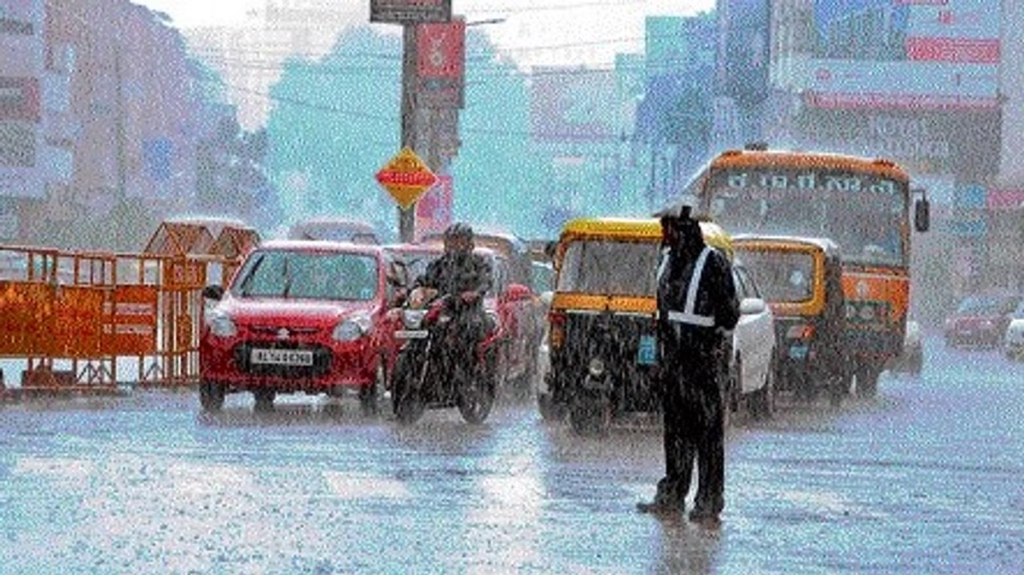Red Alert in Coastal Karnataka: Heavy Rainfall Paralyzes Mangaluru With Flooding and Landslides
Coastal Karnataka, especially Mangaluru, is grappling with the impact of relentless rain, prompting the India Meteorological Department (IMD) to issue a red alert. Over the past few days, intense downpours have caused widespread waterlogging, triggered landslides, and brought the city to a near standstill. The situation has disrupted daily life and raised serious concerns about the city’s preparedness.

Torrential Rain Brings Mangaluru to a Halt
Heavy rain battered Mangaluru throughout Sunday, leaving several parts of the city submerged. Poor drainage systems failed to handle the volume of water, flooding homes, shops, and roads. As water gushed into low-lying areas, traffic slowed to a crawl, and many vehicles stalled mid-road.
Residents from Kottara, Pumpwell, Bunder, and Hampankatta struggled to navigate flooded streets. Autos, bikes, and even cars broke down in the middle of waterlogged roads. Social media platforms filled with videos showing people wading through waist-deep water or pushing vehicles stuck in the flood.
“This happens every monsoon,” said Nithin Rao, a shopkeeper in Bunder. “We keep complaining, but nothing improves. Just a few hours of rain and our streets become rivers.”
Landslides Disrupt Connectivity
The constant rain also led to landslides in the Western Ghats, especially along the Charmadi Ghat section. Mud and debris blocked key roads, affecting traffic and transport between districts. Emergency crews rushed to the affected areas and worked overnight to clear the debris.
In response, the Karnataka State Disaster Management Authority (KSDMA) mobilized disaster response teams. Officials placed restrictions on vehicle movement along several hilly routes. Local police and forest department teams also monitored high-risk zones to prevent further damage.
IMD Issues Red Alert for Coastal Karnataka
The IMD issued a red alert for Dakshina Kannada, Udupi, and Uttara Kannada districts, warning of extremely heavy rainfall in the next 48 hours. This alert, the highest issued by the IMD, urges people to avoid non-essential travel and stay safe indoors.
The IMD attributed the downpour to a depression over the Arabian Sea, which pulled moisture-rich winds toward Karnataka’s coast. Combined with local weather patterns, the system has intensified rainfall activity across the region.
Officials advised fishermen to stay ashore due to rough sea conditions. Many schools and colleges in flood-prone areas suspended classes until further notice.
City Officials Rush to Respond
The Mangaluru City Corporation (MCC) began emergency operations early in the morning. Workers used pumps to remove stagnant water and cleared blocked drains. Teams remained active through the night, tackling repeated flooding in several pockets of the city.
“We’ve deployed multiple teams and activated helplines,” said an MCC spokesperson. “However, people must also cooperate and avoid venturing out unless absolutely necessary.”
Despite these efforts, residents criticized the city’s lack of long-term planning. Civic groups have often pointed out how unchecked construction and poor drainage systems worsen the city’s flooding every year.
“We warned the authorities before the monsoon,” said environmentalist Ravi Shetty. “They ignored us. Now the whole city suffers.”
Health Risks on the Rise
With water accumulating in various parts of Mangaluru, concerns have shifted to potential health hazards. Piles of garbage float in floodwater, and open drains overflow, raising fears of waterborne diseases such as cholera, dengue, and leptospirosis.
Doctors in local hospitals have already begun treating patients with fever and stomach infections. Medical staff anticipate a rise in such cases if the rains continue. The health department has advised clinics and hospitals to report any spikes in disease early.
“We need immediate sanitation drives and fogging operations,” said Dr. Harsha Prasad, a city-based physician. “If not, we might face a serious outbreak in the next few days.”
Citizens and Volunteers Step In
While government agencies worked round the clock, local communities stepped in to help as well. Youth groups and NGOs like the Indian Red Cross and Students Islamic Organisation (SIO) distributed food, raincoats, and essentials to those stranded in flooded areas.
Volunteers helped evacuate older residents from waterlogged homes and offered shelter where needed. “We can’t just wait for help,” said Ayaan M., a college student who joined the rescue efforts. “People in our neighborhoods need support, and we’re here for them.”
Their quick action prevented injuries and brought much-needed relief to several families affected by the downpour.
Time for a Long-Term Solution?
This episode has once again highlighted the fragile infrastructure of Indian coastal cities. Experts argue that immediate rescue measures alone aren’t enough. The city needs sustainable drainage systems, responsible urban planning, and better disaster management strategies.
Climate experts also link such extreme weather events to rising global temperatures and climate change. With increasing sea temperatures and shifting rainfall patterns, coastal cities like Mangaluru may face even harsher monsoons in the coming years.
To minimize damage in the future, authorities must invest in resilient infrastructure and community awareness. For now, officials continue to monitor the weather as more rain is expected in the next few days.






